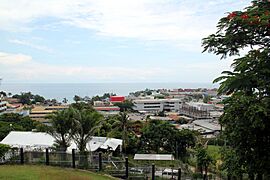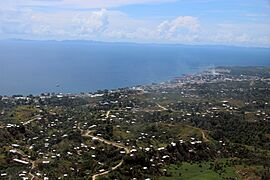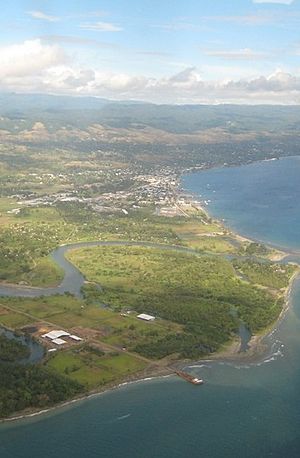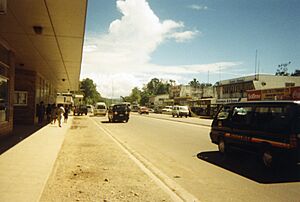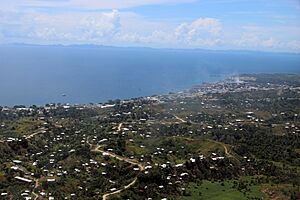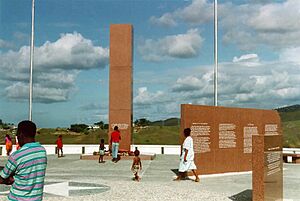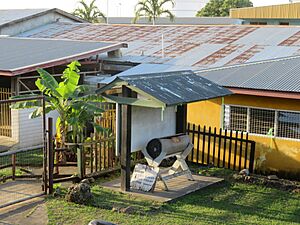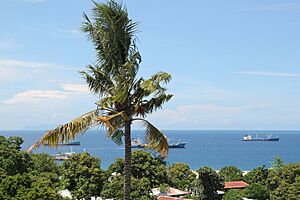Honiara facts for kids
Quick facts for kids
Honiara
Capital Territory
|
||
|---|---|---|
|
(from top: left to right) Downtown Honiara, Guadalcanal American Memorial, Honiara Harbour and Aerial view of Honiara.
|
||
|
||
| Country | Solomon Islands | |
| Province | Honiara City | |
| Island | Guadalcanal | |
| Area | ||
| • Capital city | 22 km2 (8 sq mi) | |
| Elevation | 29 m (95 ft) | |
| Population
(2021)
|
||
| • Capital city | 92,344 | |
| • Density | 4,200/km2 (10,870/sq mi) | |
| • Metro | 151,538 | |
| Time zone | UTC+11:00 (UTC) | |
| Climate | Af | |
Honiara is the capital and largest city of the Solomon Islands. It is located on the northwestern coast of Guadalcanal island. As of As of 2021[update], about 92,344 people live there.
The city has its own airport, Honiara International Airport, and a busy seaport called Point Cruz. These are important for travel and trade. Honiara is also connected by the Kukum Highway. In 1983, Honiara became a special "capital territory" with its own government, similar to a province.
The area where the airport is now was once a major battleground during World War II. The Battle of Henderson Field happened here in 1942, where the United States fought against Japan. After the war, Honiara became the new main city for the British Solomon Islands Protectorate in 1952. Many government buildings were built, and the city started to grow.
Honiara has faced some difficult times, including periods of unrest. In 2003, a group called the Regional Assistance Mission to Solomon Islands (RAMSI), made up of different Pacific nations led by Australia, came to help bring peace and rebuild the city. In 2006, there were riots that damaged parts of the city, especially Chinatown. More recently, in 2021, Honiara again experienced unrest, with attacks on the Solomon Islands Parliament Building and damage to Chinatown.
Honiara is home to most of the important government buildings and schools in the Solomon Islands. You can find the National Parliament of Solomon Islands, the Honiara Solomon Islands College of Higher Education, the International School in Honiara, and the University of the South Pacific Solomon Islands here. The city also has the national museum and a large market. Honiara is mostly Christian, with many different church headquarters located there.
Contents
People of Honiara
As of 2021, Honiara has a population of 92,344 people. This makes it the largest and fastest-growing city in the Solomon Islands. Many young people live in Honiara; about half of its residents are under 30 years old.
City History
The name Honiara comes from a local language on Guadalcanal, meaning "place of the east wind." Not much detailed history was written about the town for a long time.
World War II Impact

The Battle of Henderson Field in 1942 was a big part of the Guadalcanal Campaign during World War II. This battle happened in the area where Honiara's airport is today, about 11 kilometers (7 miles) east of the city center.
Developing the Capital
Honiara officially became the capital of the British Solomon Islands Protectorate in 1952. The United States had built a lot of infrastructure during the war, which helped the British decide to make Honiara the capital. Government buildings started opening in January 1952.
The town grew a lot after becoming the capital. In the 1960s and 1970s, two-thirds of the money for the country's development went into Honiara. This helped build many new things. Even with this growth, only about 5% of Solomon Islanders lived in the city at that time.
A local language called Pijin became very important in Honiara in the 1960s. It became the main language for many young people born in the city. From Honiara, Pijin spread and is now the main language spoken across the islands.
By 1979, Honiara was still a small capital city with about 18,346 people. In July 1978, Honiara became the capital of the newly independent Solomon Islands.
Times of Challenge
Since the late 1990s, Honiara has faced periods of ethnic tension and political unrest. There were conflicts between different groups, especially between people from Malaita and local Guadalcanal islanders.
In June 2000, there was an attempt to overthrow the government, which led to fighting in the streets. Even after a peace agreement in October 2000, violence continued. In July 2003, the situation was so difficult that Australian military and police came to help restore order, improve safety, and rebuild the city.
In 2006, riots broke out after a new Prime Minister was elected. Parts of Chinatown were destroyed, and many Chinese residents lost their homes. The Regional Assistance Mission to Solomon Islands (RAMSI) again sent more police and army officers to help. After the Prime Minister resigned, a new government was formed, and the city began to rebuild.
In 2021, Honiara experienced more unrest. The Solomon Islands Parliament Building was attacked, and Chinatown was looted and burned again.
City Geography and Climate
Honiara is on the northwestern coast of Guadalcanal island, with a port at Point Cruz. The Matanikau River flows through the city, past Chinatown. The main road, Kukum Highway, connects the city center to Honiara International Airport, which is about 11 kilometers (7 miles) to the east.
Honiara has a tropical climate, meaning it's warm all year round. The average daytime temperature is about 28 degrees Celsius (82 degrees Fahrenheit). It rains more between November and April. The city gets about 2,000 millimeters (79 inches) of rain each year. Honiara also experiences monsoons, which are seasonal winds bringing heavy rain.
| Climate data for Honiara International Airport (1991–2020) | |||||||||||||
|---|---|---|---|---|---|---|---|---|---|---|---|---|---|
| Month | Jan | Feb | Mar | Apr | May | Jun | Jul | Aug | Sep | Oct | Nov | Dec | Year |
| Record high °C (°F) | 36.1 (97.0) |
37.4 (99.3) |
35.3 (95.5) |
35.0 (95.0) |
35.5 (95.9) |
34.7 (94.5) |
34.7 (94.5) |
36.5 (97.7) |
34.6 (94.3) |
34.9 (94.8) |
35.1 (95.2) |
36.0 (96.8) |
37.4 (99.3) |
| Mean daily maximum °C (°F) | 31.6 (88.9) |
31.5 (88.7) |
31.4 (88.5) |
31.5 (88.7) |
31.6 (88.9) |
31.3 (88.3) |
31.3 (88.3) |
31.2 (88.2) |
31.6 (88.9) |
31.6 (88.9) |
31.7 (89.1) |
31.7 (89.1) |
31.5 (88.7) |
| Daily mean °C (°F) | 27.6 (81.7) |
27.5 (81.5) |
27.4 (81.3) |
27.3 (81.1) |
27.3 (81.1) |
26.9 (80.4) |
26.7 (80.1) |
26.6 (79.9) |
26.9 (80.4) |
27.0 (80.6) |
27.3 (81.1) |
27.5 (81.5) |
27.2 (81.0) |
| Mean daily minimum °C (°F) | 23.5 (74.3) |
23.4 (74.1) |
23.3 (73.9) |
23.2 (73.8) |
22.9 (73.2) |
22.4 (72.3) |
22.1 (71.8) |
22.0 (71.6) |
22.2 (72.0) |
22.4 (72.3) |
22.8 (73.0) |
23.3 (73.9) |
22.8 (73.0) |
| Record low °C (°F) | 17.6 (63.7) |
19.9 (67.8) |
19.8 (67.6) |
18.5 (65.3) |
19.0 (66.2) |
16.7 (62.1) |
16.7 (62.1) |
15.9 (60.6) |
16.9 (62.4) |
18.0 (64.4) |
18.6 (65.5) |
20.0 (68.0) |
15.9 (60.6) |
| Average precipitation mm (inches) | 239.0 (9.41) |
290.4 (11.43) |
285.0 (11.22) |
190.1 (7.48) |
111.6 (4.39) |
85.6 (3.37) |
100.3 (3.95) |
95.4 (3.76) |
90.1 (3.55) |
117.7 (4.63) |
145.3 (5.72) |
210.5 (8.29) |
1,967.8 (77.47) |
| Average precipitation days (≥ 1 mm) | 14 | 14 | 15 | 11 | 10 | 9 | 9 | 10 | 8 | 9 | 10 | 12 | 130 |
| Source: National Oceanic and Atmospheric Administration | |||||||||||||
| Climate data for Honiara | |||||||||||||
|---|---|---|---|---|---|---|---|---|---|---|---|---|---|
| Month | Jan | Feb | Mar | Apr | May | Jun | Jul | Aug | Sep | Oct | Nov | Dec | Year |
| Record high °C (°F) | 33.9 (93.0) |
36.1 (97.0) |
33.9 (93.0) |
33.4 (92.1) |
33.6 (92.5) |
32.8 (91.0) |
33.3 (91.9) |
34.5 (94.1) |
33.4 (92.1) |
33.3 (91.9) |
33.4 (92.1) |
34.8 (94.6) |
36.1 (97.0) |
| Mean daily maximum °C (°F) | 30.7 (87.3) |
30.5 (86.9) |
30.2 (86.4) |
30.5 (86.9) |
30.7 (87.3) |
30.4 (86.7) |
30.1 (86.2) |
30.4 (86.7) |
30.6 (87.1) |
30.7 (87.3) |
30.7 (87.3) |
30.5 (86.9) |
30.5 (86.9) |
| Daily mean °C (°F) | 26.7 (80.1) |
26.6 (79.9) |
26.6 (79.9) |
26.5 (79.7) |
26.6 (79.9) |
26.4 (79.5) |
26.1 (79.0) |
26.2 (79.2) |
26.5 (79.7) |
26.5 (79.7) |
26.7 (80.1) |
26.8 (80.2) |
26.5 (79.7) |
| Mean daily minimum °C (°F) | 23.0 (73.4) |
23.0 (73.4) |
23.0 (73.4) |
22.9 (73.2) |
22.8 (73.0) |
22.5 (72.5) |
22.2 (72.0) |
22.1 (71.8) |
22.3 (72.1) |
22.5 (72.5) |
22.7 (72.9) |
23.0 (73.4) |
22.7 (72.9) |
| Record low °C (°F) | 20.2 (68.4) |
20.7 (69.3) |
20.7 (69.3) |
20.1 (68.2) |
20.5 (68.9) |
19.4 (66.9) |
18.7 (65.7) |
18.8 (65.8) |
18.3 (64.9) |
17.6 (63.7) |
17.8 (64.0) |
20.5 (68.9) |
17.6 (63.7) |
| Average precipitation mm (inches) | 277 (10.9) |
287 (11.3) |
362 (14.3) |
214 (8.4) |
141 (5.6) |
97 (3.8) |
100 (3.9) |
92 (3.6) |
95 (3.7) |
154 (6.1) |
141 (5.6) |
217 (8.5) |
2,177 (85.7) |
| Average precipitation days (≥ 0.1 mm) | 19 | 19 | 23 | 18 | 15 | 13 | 15 | 13 | 13 | 16 | 15 | 18 | 197 |
| Average relative humidity (%) | 80 | 81 | 81 | 80 | 80 | 79 | 75 | 73 | 73 | 75 | 76 | 77 | 78 |
| Mean monthly sunshine hours | 186.0 | 155.4 | 198.4 | 192.0 | 210.8 | 198.0 | 186.0 | 204.6 | 192.0 | 226.3 | 216.0 | 164.3 | 2,329.8 |
| Mean daily sunshine hours | 6.0 | 5.5 | 6.4 | 6.4 | 6.8 | 6.6 | 6.0 | 6.6 | 6.4 | 7.3 | 7.2 | 5.3 | 6.4 |
| Source: Deutscher Wetterdienst | |||||||||||||
City Economy
Honiara grew much faster economically than other parts of the Solomon Islands. In the 1960s and 1970s, about two-thirds of the money invested in the country's economic growth went to Honiara. This happened even though only about five percent of Solomon Islanders lived there at the time.
Honiara is the main starting point for tourism in the Solomon Islands. The country's tourist office, the Solomon Islands Visitors Bureau, is on Mendana Avenue, Honiara's main street. You can find banks like BSP Bank, ANZ Bank, BRED Bank, and POB Bank in the city. Honiara Port can handle both local and international ships.
The periods of unrest in Honiara since the late 1990s greatly affected the economy, especially tourism. Many travel groups warned tourists to stay away, particularly in 2002 and 2003. This caused a big drop in money earned from tourism.
Important Places in Honiara
As the capital, Honiara has many important government buildings and institutions. These include the Honiara Solomon Islands College of Higher Education, the International School in Honiara, and the University of the South Pacific Solomon Islands. The Honiara Central Market is a busy place where you can find many different goods.
East of the Mataniko River, you can see the remains of a Japanese ship from World War II in the shallow water. There's also a settlement nearby called the Lord Howe Settlement, home to many Polynesians from Ontong Java Atoll. Chinatown, with its unique buildings, is another interesting area.
Honiara Children's Park is the only public park for kids in the city. It's located along the eastern coast. The park faces a challenge from erosion, where the coastline is slowly wearing away. Building a wall is needed to protect it.
War Memorials and Peace Parks
The Guadalcanal American Memorial is a popular site. It was built to mark 50 years since the Red Beach landings during World War II. It was dedicated on August 7, 1992.
The Solomons Peace Memorial Park was built by Japanese war veterans to remember everyone who died in World War II. It's about 3.5 kilometers (2.2 miles) down the coastal road. You can find other reminders of World War II around Honiara, like "Pistol Pete," a large Japanese howitzer cannon on display near the museum.
Museums and Culture
The National Museum is across from the Mendana Hotel. It shows traditional crafts and historical items, including old tools, currencies, and musical instruments. The museum's Cultural Centre has eight traditional houses from different provinces of the Solomon Islands.
The National Art Gallery holds painting exhibitions at the Old Government House. You can also visit the National Archives to see important historical documents.
The Botanical Gardens of the National Art Gallery are great for walks. They are known for their beautiful orchids and shrubs. There's also a herbarium (a collection of dried plants) and a small village display.
Schools and Learning
Honiara has several important schools and universities. These include the Solomon Islands National University (SINU), The Woodford International School, and the University of the South Pacific (USP) Solomon Islands Campus.
The Woodford International School started in the mid-1950s. It grew with help from the Solomon Islands' development plans. After the country became independent in 1978, new school buildings were built. The school is now recognized as an independent education authority.
The University of the South Pacific (USP) Solomon Islands Campus provides education to students from across the South Pacific.
Libraries and Books
The Public Library is on Belan Avenue, between Chinatown and the market. The National Library is right behind it. You can find books by Solomon Islander authors at the University of the South Pacific Centre. There are also bookstores in the city.
Local newspapers include the daily Solomon Star and weekly publications like Solomon Times and Solomon Voice.
Hospitals and Health
The National Referral Hospital of Honiara (NRH) is the main and largest hospital in the Solomon Islands. It is located across from the Honiara Hotel. As of 2012, the hospital had 300 to 400 beds and about 50 doctors.
Another hospital, originally built by Americans during the war, is now called the Nambanaen. It was greatly expanded in 1993 with help from Taiwan.
Churches in Honiara
Honiara has many churches. One of the largest is the Cathedral Church of St Barnabas, Honiara, which can seat 900 people. The Holy Cross Cathedral, Honiara is a large Roman Catholic church on a hill. All Saints Church, known for its choir and colorful wall paintings, was once the cathedral. At its entrance, you can see a large drum used to call people to prayer.
Hotels and Places to Eat
Honiara has several hotels and restaurants. The Honiara Hotel is a traditional hotel that sometimes features dance shows. The Pacific Casino is a large hotel and casino that replaced the King Solomon Hotel, which was damaged during the 2006 riots.
City Culture
In 1974, traditional Polynesian dances from Bellona Island were brought back and recorded in Honiara. These dances, like suahongi, are performed with rhythmic songs.
The Melanesia Arts and Crafts Festival was held for the first time in Honiara in 1998, with five Melanesian countries taking part.
Today, young people in Honiara enjoy freestyle dancing, often inspired by movies. You can also see traditional Panpipe performances at hotels, like the Narasirato band from Are'are. Other groups perform different traditional dances and music styles.
Religion in Honiara
Honiara is mainly Christian. It is the main center for the Anglican Church of Melanesia, the Roman Catholic Archdiocese of Honiara, the South Seas Evangelical Church, the United Church, and the Seventh-day Adventist Church. There are also many other Christian groups, as well as followers of the Baháʼí Faith, Buddhists, Jehovah's Witnesses, Mormons, and Muslims.
The Anglican Church of Melanesia was started in 1849. It covers the Solomon Islands, Vanuatu, and New Caledonia. The Church of Melanesia in Honiara runs three missions: the Melanesian Board of Mission, the Melanesian Brotherhood, and the Mission to Seafarers Society.
The Melanesian Brotherhood was founded in 1925. It is a religious group of the Anglican Communion that trains young men for religious work and spreading their faith. The Mission to Seafarers Society helps sailors in the Port of Honiara and around the world.
Sports in Honiara
Honiara has three main stadiums. The largest is Lawson Tama Stadium, which is the national stadium of the Solomon Islands. It was funded by FIFA and can hold 10,000 people. This stadium hosted the 2012 OFC Nations Cup. The city's football teams, Koloale FC and Solomon Warriors FC, are very successful in the Telekom S-League.
Yachting is popular in Honiara, and the Point Cruz Yacht Club is located on the harbor. Honiara Golf Club is on the eastern side of town. Other sports like boxing, rugby, athletics, basketball, netball, and volleyball are also played. Netball leagues are organized for girls in Honiara and nearby villages.
Getting Around Honiara
The city is located on the Kukum Highway and is served by Honiara International Airport. The airport, once known as Henderson Field during World War II, was reopened in 1969 and has been improved to handle large aircraft. Solomon Airlines, the national airline, is based in Honiara.
The seaport of Point Cruz is the main entry point for ships into the Solomon Islands. It can handle large shipping containers. Passenger boats also operate from Honiara's main wharf at Point Cruz, offering services to other islands like Malaita and western provincial cities. The boat trip to Gizo is known for its beautiful scenery.
Sister Cities
Honiara has special connections with other cities around the world:
 -Luganville, Vanuatu
-Luganville, Vanuatu -Mackay, Queensland, Australia
-Mackay, Queensland, Australia -Jiangmen, China
-Jiangmen, China -Majuro, Marshall Islands
-Majuro, Marshall Islands
Images for kids
See also
 In Spanish: Honiara para niños
In Spanish: Honiara para niños


